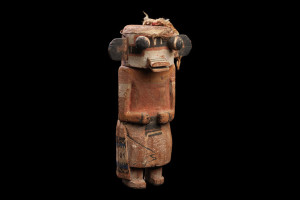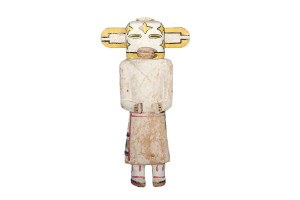
Katsina Dolls
Learn more about Katsina Dolls
Katsina dolls, which are known as tithu to the Hopi, are visual representations of the katsinam, the essential life force of all animate beings. Residing in the six cardinal directions (northwest, southwest, southeast, northeast, zenith and nadir), the katsinam are largely beneficent and life-promoting. From late December to late July, they arrive in Hopi villages. Personified by costumed dancers, the katsinam dance on plazas, advising the community on the moral conduct and admonishing those who have strayed from the right path. In the absence of a written record, the katsinam are the bearers of the community’s moral conscience. In return for the peoples’ sincere prayers, they promise to adorn themselves with clouds and rain, descending over the plantations sheltered at the foot of the mesas.
Before the commercialization of katsina dolls in the early 20th century, katsina performers would gift small figures carved in their image to young children in order to familiarize them with their songs and dances. Unlike dolls in the Western sense, these figures were displayed on the walls of the family home. Katsina dolls originally appeared as flat, board-like figures carved from the roots of the cottonwood tree. Their faces were minimally painted with native earth colours. Beginning in the middle of the 19th century, Hopi artists began creating sculptural figures in the round, featuring distinctive torsos and barely indicated legs. The more powerful the katsina's potential, the more abstract were its features. Many of the carved and painted designs on Hopi katsina dolls reference sky elements or particular water formations. Their appearance is a visual metaphor of new life.
Status: All
Category: Katsina Dolls
Results: 29





High-resolution images available. Contact Gallery for rights.
